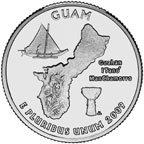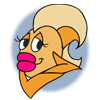Coin of the Month
Uncovering America's Heritage... Coin by Coin
Guam Quarter
In picking out my coin this month, I thought Guam might be an interesting place to write about. Well, it turns out that it sure enough is! Guam has lots going for it.
- Guam has size. It's the largest island of the Marianas and also of Micronesia in the Pacific Ocean. Guam is 30 miles long and 4 to 8 miles wide, 209 total square miles.
- Guam has two geographic regions: a plateau in the north and volcanic hills in the south. The plateau is 500 feet above sea level with cliffs along the coast and is covered in thick jungle. The mountainous ridge in the south reaches 1332 feet at Mt. Lamlam. It's windy up there, but snow is out of the question. Why? Because:
- Guam has tropical weather. Temperatures range from 70 to 90 degrees Fahrenheit all year round. Winter is simply the dry season. Most of the rain falls during the summer and fall.
- Guam has animals. One bird, called a rail or ko'ko', is a flightless bird found only on Guam. Wild deer and pigs have been introduced to the island, along with tame water buffalo. Turtles also live there, like the green sea turtle and the hawksbill turtle. The seas around Guam have more kinds of coral (more than 300 species) than anywhere else in the world.
- Guam has plants. There are flowers like hibiscus and plumeria, and trees like the mango, breadfruit, papaya, and coconut. The coconut tree is the most important plant to the island since the coconut tree provides milk, coconut "meat," and sturdy leaves.
- Guam has native people. They call themselves the Chamorro (also spelled "CHamorro" or "Chamoru"). Almost half the people on Guam are Chamorro (42 percent). The Chamorro came to Guam from Indonesia and the Philippines about 4,000 years ago. English is the official language, but the Chamorro language is still spoken as well.
- Guam has tourists. Tourism is the second most important part of the economy. Tourists mostly come from the closest countries like Japan, Australia, and the Philippines.
And, as you can see by Guams' quarter, Guam has proas and lattes. Lattes are stone pillars that used to support wooden buildings. A latte looks like a goblet or a mushroom with its cap turned upside down. The latte has become a national symbol for Guam.
The proa is a sort of canoe with a sail. European explorers were impressed with how easily these boats could be steered and how fast they could travel.
And now, besides everything else that Guam has, Guam has its own quarter design!
—Goldie


Content Related Link


